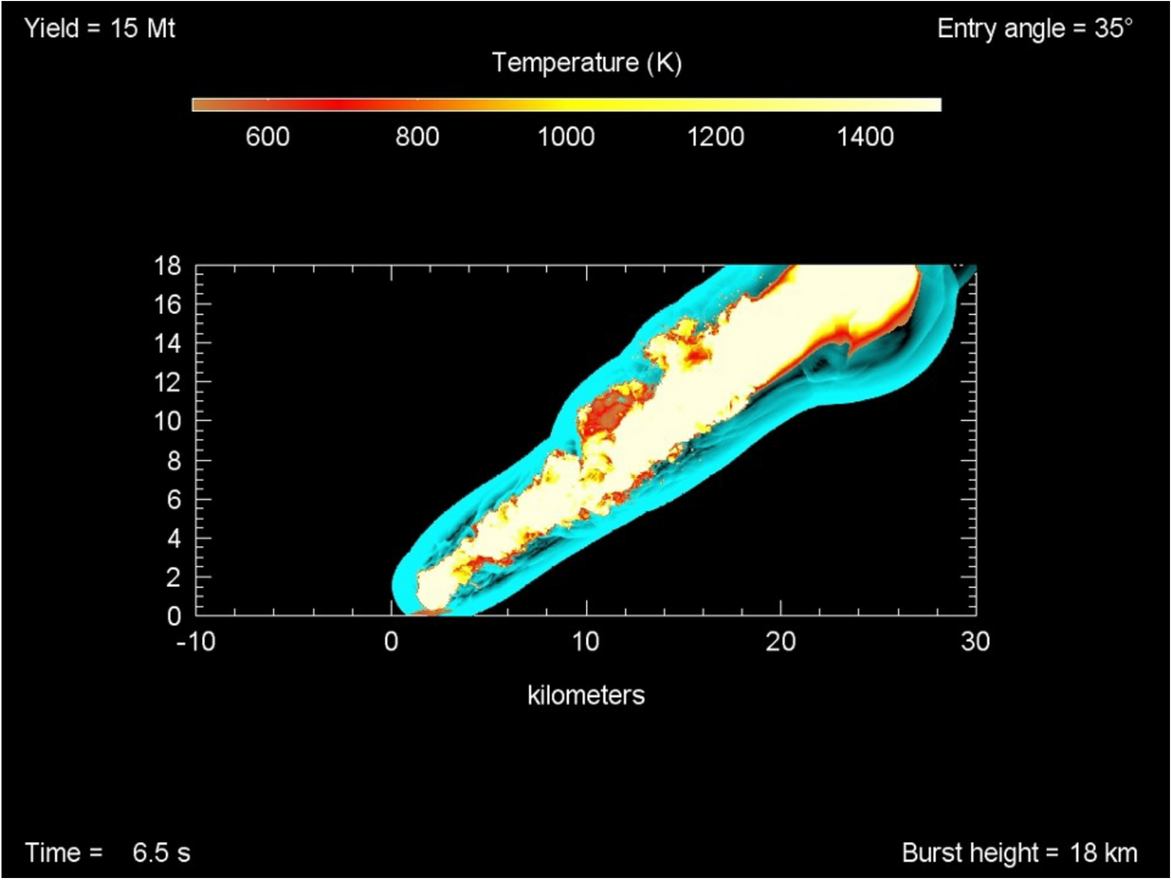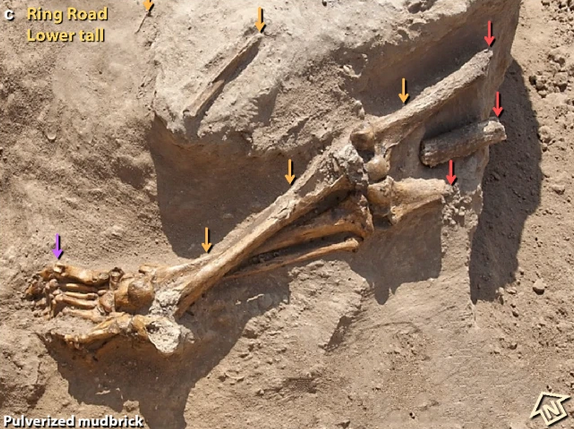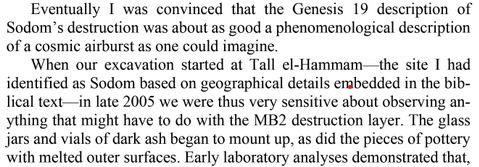Tall el-Hammam; an airburst of gullibility; it gets worse
I shared the excitement when I read at https://www.nature.com/articles/s41598-021-97778-3 that
in ~ 1650 BCE (~ 3600 years ago), a cosmic airburst destroyed Tall el-Hammam, a Middle-Bronze-Age city in the southern Jordan Valley northeast of the Dead Sea

and that this event could have given rise to the biblical account of the destruction of Sodom and Gomorrah. Then I learned that the work was conducted by a group based on an unaccredited Bible college (Trinity Southwestern University, TSU), that the world’s leading authority on airbursts has denounced the claims as impossible, that eight separate major research groups have questioned the assumptions, reproducibility, and factual accuracy of related earlier work by the corresponding author, that there is an unusually active thread criticisng the work on PubPeer, and that Retraction Watch, which says that criticism has engulfed the paper, is in correspondence with the Chief Editor of the journal, part of the Nature group, where the work appeared.

Problems listed by acknowledged experts in PubPeer include misuse of Mark Boslough‘s account of airbursts (Boslough is a long-standing critic of the claims of the TSU group); and no clear evidence that the destrution of the palace walls was catastrophic, absence of qualified examination of skeletons, anatomically misdescribed bones, claims without evidence that bone damage was associated with traumatic death, rather than later damage, the mixing of kinds of debris is commonplace and not evidence of catastrophe, the connection of the carbon-14 dates to the alleged destruction is not established, and claims of burning of bone lack evidence and consistency (Megan Perry of the Petra North Ridge Project, who knows what this kind of stuff looks like.) There is undeclared image manipulation, eventually admitted, but described as without significance. And the account of diamond vs graphite in the paper
Each diamonoid typically contains carbon atoms that are sp3-bonded (i.e., 3 bonded carbon atoms), as in diamond, rather than with sp2 bonding (i.e., 2 bonded carbon atoms), typical of graphite
does not inspire conidence.
In the paper’s Figure 44c, shadows are cast by a sun shining from the direction labelled North. This obviously cannot happen at Tall el-Hammam, giving rise to further concerns about the quality of the work.
My own browsing in what are for me odd places1 shows that other archaeologists, including Aren Maeir of Bar Ilan University, agree in finding nothing unusual in the report compared to “normal” destruction by fire or warfare) Maeir is quite explicit:
[T]he destruction the report described was not that unusual. “I see some things that remind me of phenomena that we have in the Iron Age IIA (1000–925 BC) destruction at Tell es-Safi/Gath (e.g. vitrified or “melted” bricks, ultra-high temperatures, and other things)—a destruction that is most likely caused by the conquest and destruction of the site by Hazael of Aram,” he said.
Mark Boslough, an expert on cataclysmic events who even has an asteroid named after him, tells me that he is tired of repeated rebuttal of what he considers to be obviously false claims, and of seeing his own theoretical analysis of the effect of airbursts invoked as an explanation of claims completely inconsistent with such a process, or perhaps any credible process. For this reason, rather than publishing yet another counterblast that will be ignored, he has taken to describing the controversy, extending over many years, on Twitter (see here, here, and subsequent threads, and PubPeer).
Phillip Silvia, the author from whom soil samples can be obtained, is an electrical engineer by training, who received his PhD training in archaeology at TSU, and published much of this material through TSU press in 2016 as a paperback, in which his PhD advisor, Steven Collins, strangely absent from the author list of this paper although not from an earlier abstract, states (Foreword, page x) that “the Genesis 19 description of Sodom’s destruction was about good a phenomenological description of a cosmic airburst as one could imagine” and describes Tall el-Hammam as “the site I had identified as Sodom based on geographical details embedded in the boblical text”.
Like I suspect many of the journalists and interested readers who swooped on this story, I failed at first to notice that the paper was not, despite the link, an article in Nature but in Scientific Reports. This is one of the stable of less exclusive journals closely linked to Nature being published by Springer, now controlled by the publishing giant Hotlzbrinck, and profiting from Nature’s reputation for excellence. I was only vaguely aware of the authors’ long history of invoking airbursts, took the many kinds of evidence listed at face value, and did not even blink at the claim that “[a]n airburst-related influx of salt (~ 4 wt.%) [from the Dead Sea, apparently] produced hypersalinity”.

The authors have since described this work to a much larger audience in The Conversation, where they repeat their claim, also published in Scientific Reports, of a similar catastrophe at Abu Hureyra in what is now Syria, around 10,800 BCE, assert that “it almost certainly won’t be the last time a human city meets this fate”, claim that such events “pose a severe modern-day hazard”, and advise that “unless orbiting or ground-based telescopes detect these rogue objects, the world may have no warning, just like the people of Tall el-Hammam.” The Abu Hureya paper also repeats a litany of earlier claims that the Younger Dryas, a period of severe cold in the northern hemisphere from around 12,900 to 11,700 years Before Present [Present is fixed at 1950 CE], was caused by a series of impacts with cometary debris, spread over at least four continents. These claims have been severely disputed; see papers listed below.
There are numerous additional reasons for concern about the TSU researh group.

The paper tells us that “The project is under the aegis of the School of Archaeology, Veritas International University, Santa Ana, CA, and the College of Archaeology, Trinity Southwest University, Albuquerque, NM, under the auspices of the Department of Antiquities of the Hashemite Kingdom of Jordan.” Veritas International University believes in “the full historicity and comprehensibility of the biblical record”. It is accredited by the Transnational Association of Christian Colleges and Schools (TRACS), which I have discussed here before. Trinity Southwest University, which now operates from an office in a strip mall in Albuquerque, was formerly in Tulsa, Oklahoma, under the name Southwest Biblical Seminary, and rejects any government accreditation whatsoever as intrusive violation of the separation of Church and State. While the traditional site of Sodom is in Israel (and within the pre-1967 boundaries).

The corresponding author is Allen West, who has been publishing prolifically in this area since 2005 (Evidence for the Extinction of Mammoths by an Extraterrestrial Impact Event) and in 2006 co-authored a book, The Cycle of Cosmic Catastrophes: How a Stone-Age Comet Changed the Course of World Culture, which claims that the debris of a shattered comet was responsible for “a cosmic chain of events [that] began 41,000 years ago and culminated in a major global catastrophe 28,000 years later.” These events include everything from the extinction of the mammoths to the landform of the Carolina Bays to the legend of Atlantis to a purported “mysterious layer of black sediment” found spanning North America to the Younger Dryas discussed in the Abu Hureya paper. West has no academic qualifications or affiliations, and gives his address as Comet Research Group (CRG), Prescott, Arizona (several of the other authors are also members of this group, which is linked to the Rising Light Group, a 501(c)3, tax-exempt charitable organization with a clear Christian and biblical agenda, registered in Allen West’s name.). As detailed by Pacific Standard Magazine, discussing how thing stood regarding CRG’s work in 2017, there have been calls for a for a formal inquiry and
University of Wyoming archaeologist Todd Surovell and his colleagues couldn’t find increased magnetic spherules representing cosmic debris at seven Clovis sites. Nicholas Pinter and his colleagues at Southern Illinois University Carbondale argue the carbon spherules are organic residue of fungus or arthropod excrement. And Tyrone Daulton of Washington University in St. Louis and his colleagues reported that supposed nanodiamonds formed by the impact were misidentified.
On the other hand, in an acrimonious exchange with me in the Comments section of The Conversation, West pointed out that
Our group included, among many others: Dr. James Kennett, emeritus professor at UCSB, specializing in stratigraphy, micropaleontology, paleobiology. He is a member of the National Academy of Sciences, which recognizes the contributions of just 0.1% of all scientists. Dr. Ted Bunch, former NASA section chief and a world-leading meteoriticist. Dr. Robert Hermes, retired from Los Alamos National Labs, world-recognized expert in trinitite or atomic glass. Dr. Wendy Wolbach, chemistry professor who discovered high-temperature soot at the K-Pg boundary.
I replied with a listing of some papers that I have examined criticising West’s own earlier work regarding airbursts, including sampling techniques and claimed evidence for very high temperatures:
Scott AC, Hardiman M, Pinter N, Anderson RS, Daulton TL, Ejarque A, Finch P, Carter-champion A (2017). “Interpreting palaeofire evidence from fluvial sediments: a case study from Santa Rosa Island, California, with implications for the Younger Dryas Impact Hypothesis”. Journal of Quaternary Science. 32 (1): 35–47. doi:10.1002/jqs.2914.
*Boslough M, Harris AW, Chapman C, Morrison D (November 2013). “Younger Dryas impact model confuses comet facts, defies airburst physics”. Proceedings of the National Academy of Sciences of the United States of America. 110 (45): E4170. doi:10.1073/pnas.1313495110.
*Boslough M (April 2013). “Faulty protocols yield contaminated samples, unconfirmed results”. Proceedings of the National Academy of Sciences of the United States of America. 110 (18): E1651. doi:10.1073/pnas.1220567110
Van Hoesel A, Hoek WZ, Pennock GM, Drury MR (2014). “The Younger Dryas impact hypothesis: a critical review”. Quaternary Science Reviews. 83: 95–114. doi:10.1016/j.quascirev.2013.10.033.
*Meltzer DJ, Holliday VT, Cannon MD, Miller DS (May 2014). “Chronological evidence fails to support claim of an isochronous widespread layer of cosmic impact indicators dated to 12,800 years ago”. Proceedings of the National Academy of Sciences of the United States of America. 111 (21): E2162-71. doi:10.1073/pnas.1401150111.
*Holliday VT (December 2015). “Problematic dating of claimed Younger Dryas boundary impact proxies”. Proceedings of the National Academy of Sciences of the United States of America. 112 (49): E6721. doi:10.1073/pnas.1518945112.
Thy P, Willcox G, Barfod GH, Fuller DQ (2015). “Anthropogenic origin of siliceous scoria droplets from Pleistocene and Holocene archaeological sites in northern Syria”. Journal of Archaeological Science. 54: 193–209. doi:10.1016/j.jas.2014.11.027.
*Van der Hammen T, Van Geel B (2016). “Charcoal in soils of the Allerød-Younger Dryas transition were the result of natural fires and not necessarily the effect of an extra-terrestrial impact”. Netherlands Journal of Geosciences. 87 (4): 359–361. doi:10.1016/j.jas.2014.11.027
See, however, in defence of the Younger Dryas impact theory, *Sweatman MB (2021). The Younger Dryas Impact hypothesis: Review of the impact evidence. Earth-Science Reviews. 218: 103677. doi:10.1016/j.earscirev.2021.103677. I thank Christopher R. Moore, one of the authors of the paper I am criticising, for drawing my attention to this review.
*Freely accessible via doi; for other papers, doi gives access to abstracts but not full text.
We await further developments with interest.
1] Bit for a rebuttal by a biblical archaeologist involved in the dig, though not an author on this paper, see here
An earlier edition of this post appeared on pandasthumb.org
Posted on October 14, 2021, in Creationism, Science and tagged Airburst, Allen West, Aren Maier, Mark Boslough, Sodom, Tall el-Hammam, Trinity Southwestern University, Veritas International University, Younger Dryas. Bookmark the permalink. 28 Comments.


It really is quite annoying that we have to always be alert from the theist trying to sneak things in.
Related: Persepolis still retains some scorched stone from Alexander burning the place down.
LikeLiked by 1 person
Reblogged this on Peddling and Scaling God and Darwin and commented:
Another appeal to proof of the Bible which must be taken with a pillar rather than a pinch of salt!
It’s a claim to explain the destruction of Sodom and Gomorrah. It is sciencey but emanates from a nutty establishment in Alberquerque or shall I say here alber quirky!!
Any attempt to tie an event into the scanty details of Genesis is always fraught as there simply so little to latch on to.
It is easier for later parts of the bible and the New Testament where there is mopre detail in the text.
This article which some fell for is a classic example of desperation in proof.
Paul has given a good and fair assessment and should be a warni
ong to naive Christians desperate for verification of the Bible.
(For myself I accept Abraham et al were historical figures but only have the very scanty statements in the bible. All we can say is that the accounts “fit in” with the sitz im leben of 2000BC and no more)
LikeLiked by 1 person
Ironically enough, Answer in Genesis is not buying this interpretation:
https://answersingenesis.org/archaeology/did-space-rock-destroy-sodom-gomorrah/
“Furthermore, that location doesn’t match the biblical description of where the historical Sodom and Gomorrah were. And, keep in mind that Lot, his wife, and his daughters fled the city of Sodom to go to Zoar. A blast that powerful would have killed them even in Zoar, which was described as very close to Sodom (Genesis 19:20-23). Also, the destruction of these cities, as well as the other cities such as Admah and Zeboim on the plain, wasn’t a story “inspired” by some naturalistic event—it was a divinely ordained destruction, sent by God to judge their incredible wickedness.
So, no, Sodom and Gomorrah were not destroyed by an asteroid that “inspired” the biblical account—they were destroyed just as the Bible states. And that’s a reminder to make sure we judge people’s interpretation of past events from the foundation of God’s Word! If the interpretation doesn’t match, then it’s wrong. “
LikeLiked by 2 people
I mentioned this in an earlier version (gullibility https://pandasthumb.org/archives/2021/10/tall-el-hammam-gullibility.html), where I added a footnote:
Somewhat to my surprise, Ken Ham of Answers in Genesis did not share my initial excitement. I now think that Ken’s conclusion [1] was right and I was wrong. [1] Though not his reasoning, Ken’s argument is based on his Ussher-style biblical timeline, which places the call of Abraham at 1922 BCE, whereas the destruction of Tall el-Hammam is dated to ~ 1650 BCE. For what it’s worth (not much, I know), this disagreement would disappear if we use, instead, the traditional Jewish date of 3760 BCE for the Creation.
LikeLiked by 1 person
It takes a big man to acknowledge that he was wrong and Ken Ham was right, on anything 🙂
Anyway, nice job laying out the latest takes on this story.
LikeLiked by 1 person
Just catching up on loose ends in my emails after some time offline. Glad you spotted the connections between the Sodom airburst bunch and the Younger Dryas impact brigade (which has been running almost non-stop for 15 years, especially at PNAS). Jackson Wheat and I are including sections on both topics in Vol 2 of “The Rocks Were There” (finishing up our critique of the Answers in Genesis creationist worldview).
LikeLiked by 1 person
The same journal that published the original claims recently (3/25/2022) published this critique:
https://www.nature.com/articles/s41598-022-08216-x
LikeLiked by 1 person
Underthe devastating heading: No mineralogic or geochemical evidence of impact at Tall el-Hammam, a Middle Bronze Age city in the Jordan Valley near the Dead Sea
LikeLiked by 1 person
Another source to add to Vol 2 of “The Rocks Were There” 🙂
LikeLike
Or in ths case, regarding the shocked quartz, the rocks *weren’t* there
LikeLike
How do any of these people explain the fact that Trinitite was found in the middle bronze age stratum or that this is the only site I’ve heard of whose destruction show a clear, single directionality to it?
LikeLike
I just commented but wanted to add that I am basing my conclusions on the assumption that the people whose work I learn from aren’t outright lying. For example, I believe Trinitite was found there and that nuclear explosion levels of heat are required to create it.
LikeLike
Pingback: The scientific meltdown over a controversial discovery of ‘biblical Sodom’ - Olusolacoker.com
Pingback: The scientific meltdown over a controversial discovery of ‘biblical Sodom’ – One Day Deals
Pingback: The scientific meltdown over a controversial discovery of ‘biblical Sodom’ – Orlando News Station
Pingback: The Scotfree | The scientific meltdown over a controversial discovery of ‘biblical Sodom’
Pingback: The medical meltdown over a debatable discovery of ‘biblical Sodom’ – Bezaleel Global Ministries
Pingback: The scientific meltdown over a controversial discovery of ‘biblical Sodom’ - News WordPress theme
Pingback: The scientific meltdown over a controversial discovery of ‘biblical Sodom’ - SAVED News
Pingback: The Scientific Meltdown Over a Controversial Discovery of ‘Biblical Sodom’
Pingback: The scientific meltdown over a controversial discovery of ‘biblical Sodom’ - Olusolacoker.com
Pingback: The scientific meltdown over a controversial discovery of 'biblical Sodom' | Leland Baptist
Pingback: The scientific meltdown over a controversial discovery of 'biblical Sodom' - powermeentrepreneurs
Pingback: The scientific meltdown over a controversial discovery of 'biblical Sodom'
Pingback: The scientific meltdown around a controversial discovery of ‘biblical Sodom’ – CloudsBigData
Pingback: The scientific meltdown over a controversial discovery of 'biblical Sodom'
Pingback: SCIENTISTS BATTLE OVER BIBLICAL LOCATION OF SODOM AND GOMORRAH — PatriotandLiberty
Pingback: Meteorite That Struck A New Jersey House May Be From Halley’s Comet